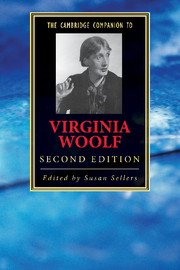Book contents
- Frontmatter
- 1 Bloomsbury
- 2 Virginia Woolf’s early novels: Finding a voice
- 3 From Mrs Dalloway to The Waves: New elegy and lyric experimentalism
- 4 The novels of the 1930s and the impact of history
- 5 Virginia Woolf’s essays
- 6 Virginia Woolf, modernism and modernity
- 7 The socio-political vision of the novels
- 8 Woolf’s feminism and feminism’s Woolf
- 9 Virginia Woolf and sexuality
- 10 Virginia Woolf, Empire and race
- 11 Virginia Woolf and visual culture
- 12 Virginia Woolf and the public sphere
- Guide to further reading
- Index
12 - Virginia Woolf and the public sphere
Published online by Cambridge University Press: 28 July 2010
- Frontmatter
- 1 Bloomsbury
- 2 Virginia Woolf’s early novels: Finding a voice
- 3 From Mrs Dalloway to The Waves: New elegy and lyric experimentalism
- 4 The novels of the 1930s and the impact of history
- 5 Virginia Woolf’s essays
- 6 Virginia Woolf, modernism and modernity
- 7 The socio-political vision of the novels
- 8 Woolf’s feminism and feminism’s Woolf
- 9 Virginia Woolf and sexuality
- 10 Virginia Woolf, Empire and race
- 11 Virginia Woolf and visual culture
- 12 Virginia Woolf and the public sphere
- Guide to further reading
- Index
Summary
What impact, during the modernist period, could a writer, writing as an artist, hope to have in the public sphere? In the mid-nineteenth century, Alfred Lord Tennyson was able to write a profoundly personal poem that simultaneously engaged some of the most troubling controversies of his time: the challenges posed by the developing geological and biological sciences to the very foundations of a society based on religious faith. In Memoriam was not only immensely popular throughout the full spectrum of the Victorian reading public; the poem itself made a significant and influential contribution to the debates. By the modernist period, not only had the reading public become more fragmented and diversified - a phenomenon Virginia Woolf confronted in her essay 'The Patron and the Crocus'; in addition, literature itself had moved, due in part to the increasing predominance of scientific discourse, into a more private, and hence less socially influential, space. In consequence, most discussions of modernist public engagement focus on genres that directly and transparently target communal ears: non-fictional writing disseminated through periodical essays, newspaper journalism, letters to editors and radio broadcasts.
But can we meaningfully divide Virginia Woolf's writing into two generic and locational halves? We have before us a writer whose total uvre, as Anna Snaith has cogently argued, negotiated and contested the nineteenth-century division of male and female into gendered public and private separate spheres. Furthermore, lingering in that putative separation threatens not only to lose the public significance of Woolf's fiction; it also, I suggest, generates readings likely to miss the full public import of her non-fictional works as well.
- Type
- Chapter
- Information
- The Cambridge Companion to Virginia Woolf , pp. 231 - 249Publisher: Cambridge University PressPrint publication year: 2010
- 1
- Cited by



